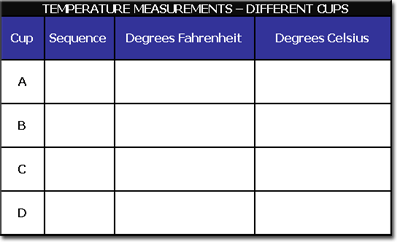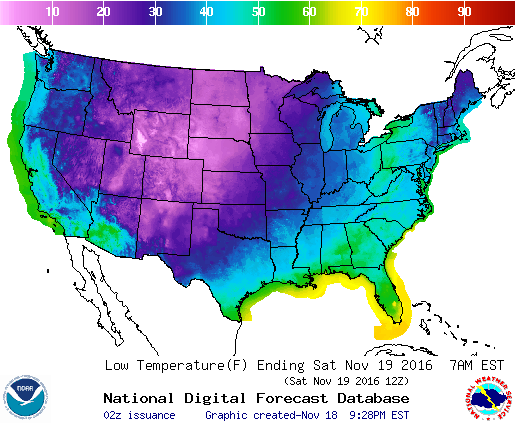Teaching and Learning Focus
Temperature Investigation Question 1 gave students experience with relative temperature (i.e. warmer, cooler). Your students can be very adept at observing things compared to one another, and observing changes. They may have less understanding about how conditions and changes can be measured using units. This investigation will help them understand that temperature can be measured using standard units (in this case degrees Fahrenheit and degrees Celsius.)
Materials Needed
- 3 foam drink cups marked A, B and C large enough to put hands in - each should contain water at the different temperatures shown below:
Cup A
Water slightly warmer than body temperature, about
100 °F/38 °C
Cup B
Cold water at a temperature of about
45 °F/7 °C
Cup C
Water that is at or near room temperature
72 °F/22 °C
- Regular alcohol thermometers calibrated in °F and °C
- Paper towels
Safety
This investigation question is considered generally safe to do with students. You should check that the heated water is not too hot to handle. Please review the investigation for your specific setting, materials, students, and conventional safety precautions.
Setting the Scene
In the last investigation question students sequenced cups by relative temperature. That works well as long as the cups with water to be compared are very near each other. When comparisons have to be made less directly, problems can arise. To illustrate this you can set three cups around the room, each with a different temperature of water (each should be close room temperature, only a little different from one another.) Have three volunteers help you by standing at each cup. Tell them to sequence the cups by temperature. Tell them to work together, but without moving. They will find it very difficult, since each is unable to compare his cup with the other two. In this case, descriptions do not work well. You can allow the students to move around the room to the other cups, and still it will be difficult to sequence the temperatures. Imagine if this were being done at an even greater distance, such as if you were trying to describe the temperature of the water in the cup to someone in another town (such as for a recipe.) Describing temperature using numbers (i.e. measurements) can help with this kind of communication.
Presenting the Investigation Question
Introduce your students to the investigation question: "How can we describe temperature using numbers?"
Have your students discuss the question in pairs, then in groups, and then as a whole class. Record their answers on the flipchart.
Have your students brainstorm ideas about how this investigation question could be investigated.
- Design an experiment that could be used to test the investigation question.
- What materials would be needed?
- What would you have to do?
- What would be measured?
- How long would the experiment take?
Assessing What Your Students Already Know
From the preceding Temperature Investigation Question 1, your students will know that a liquid can exist at different heat levels (i.e. temperatures) and that this can be seen using a blank thermometer. It is also likely that most students will have some idea of temperature measurement. They will probably know that it feels hot outside when people say it is 90 degrees, or cold when the temperature is reported at several degrees below zero. What they may not understand is just what a degree is in terms of a measurement unit. They may also not know that there are two different measurement scales, English (Fahrenheit) and metric (Celsius or Centigrade), and that the metric, or Centigrade, is the scale conventionally used in science.
Exploring the Concept
- Set up cups with three temperatures of water as you did for Temperature Investigation Question 1. Give students the calibrated thermometers. Have them repeat the insertions into the three cups as they did in Temperature Investigation Question 1, but this time help them to read and record the different temperatures in both degrees Fahrenheit and degrees Centigrade. As they did before, they can determine the sequence of the cups based on temperature, but this time using measurements instead of a relative scale. To do this they can construct a chart like the one below, or a computer version (Your students should learn that it is important in science to use tools, such as computers and calculators, observational procedures and recording techniques such as tables):
Adobe PDF (13 KB) | Word Document (30 KB) - Now have your students look closely at two measurements, °F and °C. Ask them to note and discuss the differences (This is a good opportunity to introduce the idea that for a unit of measurement to work, a group of people have to all agree to use it. The Fahrenheit and Celsius scales are usually included on thermometers because each is used by different groups - Fahrenheit, which is an older traditional measure, is used in the United States, Celsius, which is newer, is used in most other countries in the world. Celsius is also the unit mostly used by scientists.)

- Provide a cup D (with a lid if possible) with water within the range of the temperatures of cups A through D, and have the students again add it to the sequence, but this time using the temperature measurement of the water in the cup. Do all the groups have water the same temperature in the cup marked D? How does measuring make it easier to answer that than it was in Temperature Investigation Question 1 with just relative comparisons to use?
- Get your students to think about air and how it is often cooler at some times, or in some places, than others. Let them see what the temperature is in the classroom. (You can ask different students in different parts of the room call out their observed temperatures to see if they are the same or different in one area of the room and another. Students near a window or an air vent may find that their measurements are several degrees above or below those of other groups.)
- If the outside air is quite different to the classroom temperature (hot or cold day) have your students go outside to measure and record the air temperature. (This is an opportunity to help your students begin to understand that the temperature of air is an important part of "weather". Again, as in the classroom, different locations may provide different temperature readings depending on specific conditions.)
- Tell the students that it will be their job to record the outdoor temperature daily for ten school days. They will need to do this in order to describe current weather conditions throughout the period. They will also record other factors to describe the conditions and to compare one day to the others. (Your students should devise a good way of recording this information. Help them to design an appropriate chart, computer data program, or other method.)
- Ask the students why it will be important to record the temperature in the same location and at the same time each day. (Even young children will see the need for such controls in keeping records. You might reinforce this by asking if it would be fair to measure the temperature at different times of day as they compare one day's conditions to the next.)
Applying Students' Understanding

© NOAA/NWS
To assess how your students understand how measuring air with a thermometer is related to weather show them a local newspaper weather report and/or a video recording of a television weather forecast. Ask them to:
- find as many connections they can between their temperature recordings and the information given in the reports and forecasts;
- discuss why air temperature is usually shown and why people often want to know about it.
Revisiting Investigation Question 2
Complete this investigation question by asking your students to reflect on "How can we describe temperature using numbers?" and how their answers may have changed as a result of what they have learned. While numbers can express relative temperature (1st, 2nd, 3rd), using a standard temperature scale with degrees Fahrenheit or Celsius allows for descriptions and comparisons across distances and over time.
Weather Unit Sections
How can we put things in a sequence by how hot they are?
How much can air temperature change during a day?
